Interview taken from „Ženski Magazine“
Right at the entrance of the town of Debar is the village of Rajčica, where the Monastery of St. George the Victorious is located on a high vista offering a view that is more like fantasy than reality. The Monastery is one of four metochia of Bigorski Monastery. The Monastery’s church is distinguished by its especially beautiful frescoes with a very special shade of blue that was typical of iconographers of the Reka region. There, one can hear the enchanting voices of the nuns during services, singing in Byzantine chant and awakening everyone who attends with faith, hope, and love. While we often neglect to attend the church’s daily cycle of services in the world because of our many burdens; this neglect gives rise to our anxieties and fears that we experience. The nuns, however, do not forget to pray with the Church. Their ascetic lives, spiritual and moral purity, obedience, and constant prayer for all of us ordinary people, along with their love, all attract our attention and make us want to talk to them all the more.
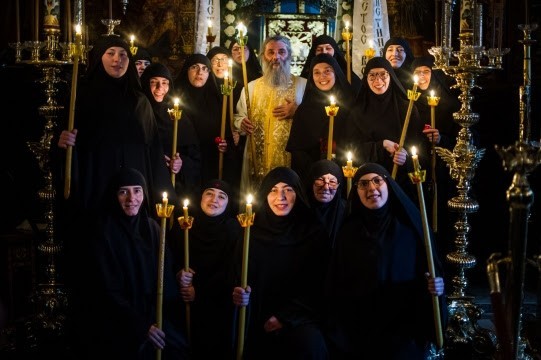
The task of being the Monastery’s superior was entrusted to Nun Kassiana by His Grace, Bishop Partenij of Antania, who also gave us his blessing for this interview. Since the Nativity Fast begins today (November 28th), we of course asked about how we should fast, along with monasticism, the symbolism behind monastic tonsure, and what rules guide a monastic’s life. We also talked about their work making bishop’s miters, the miracles performed by the Monastery’s relics of St. George, and we got an answer to many women’s concerns about wearing a headscarf in church. Lofty thoughts will encircle you as you read Sister Kassiana’s deep reflections, and you will find yourself coming ever closer to that great and unutterable joy.
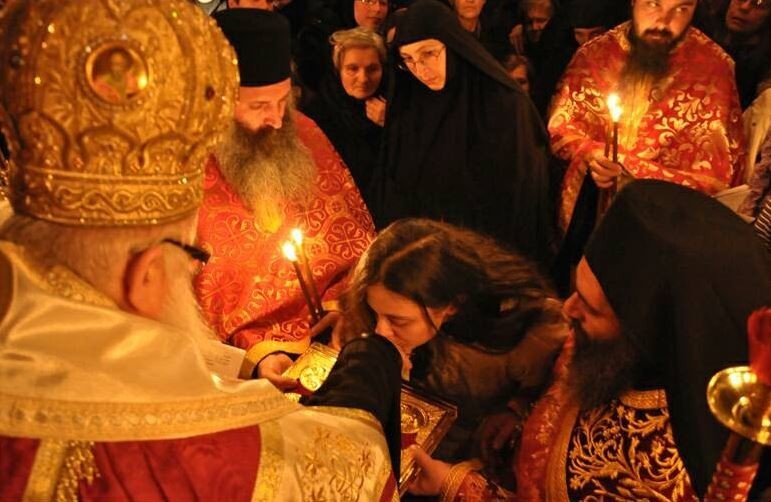
Given that a little more than ten years have passed since you became a nun (March 2012), as we begin our conversation, will you describe to us the feelings you had then, how it all unfolded or what started this journey for you? Do you feel the same today? What is the symbolism of monastic tonsure? And of course, is the ceremony public? Can anyone attend it?
—That day still lives in me very vividly and I always feel like it almost just happened, and it is something that is repeated daily in my heart. I believe that it is a sacrament that every monastic experiences, when you crucify yourself to this world and accept the gentle yoke of monastic life. To describe the sublime beauty of monastic life, I think it is more than enough to quote our Elder, Bishop Partenij of Antania, Abbot of Holy Monastery of Bigorski, who with his great spiritual experience and deep love for the monastic life said, “Believe me, I am always telling God that my wish is to end up in a monastery as a MONK!” Some people think this is a simple request, but for me, it’s actually a very important and even almost presumptuous request! To end up in a monastery as a monk seeking the Kingdom of Heaven — that is the greatest thing one could ask for!” And indeed, the words of the Elder are so profound, they reveal the ultimate goal not only for monks or nuns but for every Christian! Consequently, the ultimate goal for each of us, regardless of where we are, whether we are in a monastery or in the world — because the world is also a monastery where a person should find God and live in communion with Him — is to be reconciled with Christ, so that we gain the necessary strength for all of life’s temptations and challenges. He calls us with His wonderful words from the Gospel: “Come unto Me, all you who are weary and heavy-laden, and I will give you rest.” Christ Himself is the Kingdom of Heaven and only in Him can we find the true peace that we all so desperately need.
The monastic tonsure itself is like a second baptism, a new life in Christ. The Holy Apostle Paul writes, “Therefore, if anyone is in Christ, he is a new creation; old things have passed away; behold, all things have become new” (2 Corinthians 5:17). Then we get a new monastic name and an invisible struggle begins so that the new man in Christ will become truly alive, and the old one will slowly fade away. On the topic of tonsure, I want to share something from my heart. I have a lasting spiritual impression from when at the service of monastic tonsure, before the tonsure itself and receiving a new monastic name (I was named Dragana and became Kassiana), our Metropolitan Timothy of Debar and Kičevo put the scissors on the Holy Gospel book and repeated the same words three times: “Pick up the scissors and give them to me.”
In a mysterious way, the great and mysterious counsel of God was revealed to me again, I was touched by God’s unfathomable mercy and was shaking in my whole being. Why? Because I, the least of all, was called by the Greatest; I, the sinner, was met by the Sinless One, who extended his love to me (expressed through the scissors, as a symbol of dying to the world and sinful desires that lead to death and decay), as a bridge from Earth to Heaven. I felt His extreme humility. I was shaken by the fact that He, the Sweetest One, once again showed His infinite love for humanity, humbled Himself enough to give Himself to me, who am a big nothing! He Himself gave me the grace to choose Him, the Eternal, the Most Beautiful, the Life-giving! Glory be to His Name and I thank Him for everything!
After all these years, I can only confirm that all the good that we have in us, even the tiniest good thought, is thanks to the mercy of God, according to the measure of our self-denial, and because of our Elder’s blessing.
Usually, a tonsure takes place on a Great Feast, first of all in the presence of the Heavenly Church, and then in the presence of the Earthly Church, before anyone who by God’s Providence is present in the Monastery at the time. It takes place before all who would be witnesses to this great mystery in their spirits, this mystical marriage of a soul with Christ the Heavenly Bridegroom.

Your monastic name is Kassiana. Did you choose it yourself? Is it Greek? Does it have any meaning? How are monastic names chosen in the Orthodox Church?
—My monastic name was given to me by my elder and spiritual father, Bishop Partenij, in honor of my beloved heavenly protectress, Saint Kassiana the Poet (sometimes also called Cassia), one of the most famous female hymnographers in the Church, who lived and worked in the 9th century. She was of noble birth and was very educated, filled with virtue. Saint Kassiana was distinguished by her spiritual beauty and great wisdom. In 834, she founded a monastic community west of Constantinople, near the city walls, and became its first abbess. She was a great poet and prayer warrior of our Church.
I have come across two interpretations of the name Kassiana. The more common one says that the name comes from the Latin adjective “cassus” which translates as “empty, emptied” and in that context, in a Christian sense, the person who bears that name should be emptied of all evil and egoism, of the corrupting passions of this world, and become filled with God. Also, this name is connected with the Latin word “cassis” which means “metal helmet” and in a spiritual sense would mean the “helmet of salvation” spoken of by the Apostle Paul in the Epistle to the Ephesians.
However, in my opinion, there is another more plausible theory about the origin of the name Kassiana. According to some etymological studies, it comes from the ancient Hebrew term “ketsia” (Greek and Latin “cassia”) which means cinnamon. In this case, the name Cassia signifies the spiritual fragrance with which the Christian soul should have. After all, we find the personal name Cassia in the Old Testament, where we read that one of the daughters of Saint Job the Long-suffering had that name.
As far as the choice of monastic name, it is an ancient tradition in the Church that the spiritual father of the future monk or nun chooses it, based on spiritual characteristics that they have in common with the Saint, or because of their great love and devotion to them. Both of these are true in my case. My Elder Partenij knew from the beginning about my love for St. Kassiana, and then there was also the fact that I was an opera singer in the world and all my life had been related to music.
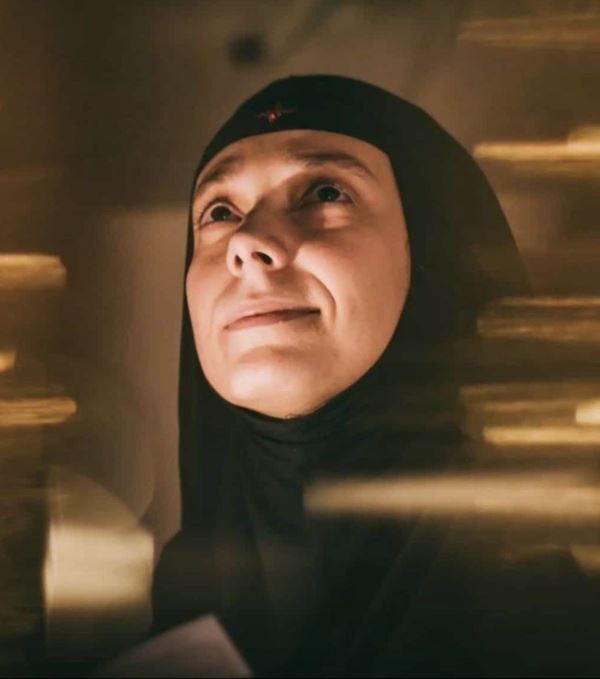
When it comes to the last ten years of your life, of your monastic life, how do you look back on it? How do you look at time? For example, does your birthday still mean anything to you? Do you count the years as they go by or does it not really matter? Basically, how do you view timelessness? Is man a timeless being?
—- I will start by saying that life is the greatest gift! For me, man and the life of each individual represent a great mystery, the mystery of God’s love. God has put tremendous power in the soul of man. It depends only on us how we will use that power – whether for good or for evil. Time can become our greatest friend or greatest enemy. It depends on our inner state, whether we cling to the Light or the darkness. That is why it is not the years of our lives that are important, but rather the LIFE that we lead in our years, which are a gift from God! The day of our birth is a mercy because God has granted us to exist. That is why we should strive to come out of this life as pure as we entered it. After all, how was it that we came into this life? The Lord Jesus Christ says: “Assuredly I say unto you, whoever does not receive the Kingdom of God like a child will by no means enter it” (Luke 18:17).
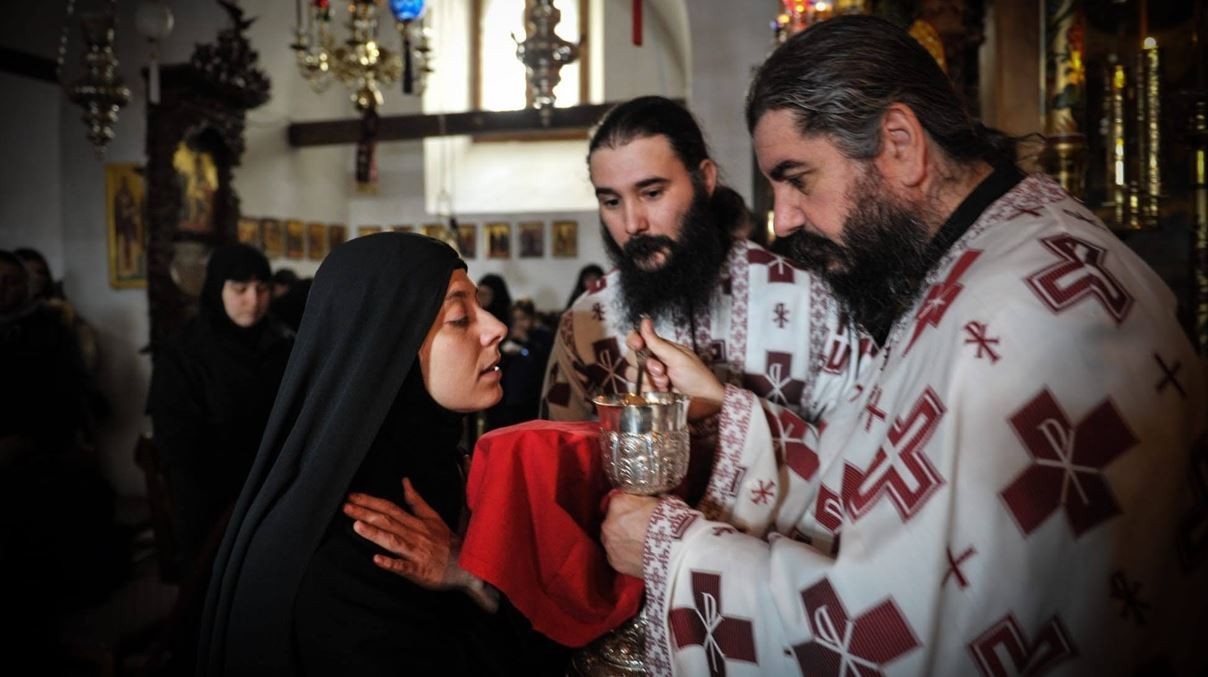
You are the superior of the Monastery of Saint George the Victory-Bearer in Rajčica, which is a metochion of Bigorski. The whole complex looks like paradise. The church is quite old. From when does it date? And the fresco painting is amazingly beautiful, dominated by a special blue color. Will you tell us something about it?
—Our Monastery’s beginnings as a metochion of Bigorski are connected with Abbot Hilarion, but it reached its height during the time of Abbot Arsenij, who in 1835 built the current church and arranged for the church to be frescoed, which was completed during the tenure of Abbot Joakim, Elder Arsenij’s successor. Thus, our Monastery was the fruit of the prayers and work of three Bigorski abbots. Of course, here I must also mention the unforgettable role of our beloved Elder, Bishop Partenij of Antania, who in 1999, with great diligence, self-sacrifice, and strong faith in Saint George the Victorious, began to resurrect this almost forgotten holy place from the ruins. At the powerful intercession of our beloved Patron, St. George, God mercifully looked upon the work of His hands and performed a miracle. Amid military conflict, riots, and poverty, in less than two years He erected this beautiful fortress of the Great Martyr, which is the home of our sisterhood today. And as every beginning is difficult, so the beginning of today’s Rajčica Monastery began in very unfavorable conditions, with a strong sense of post-war uncertainty hanging in the air. But St. George is a powerful and invincible protector, and thus he protectively overshadowed the first sister who came to serve God, Sister Varvara, and after eight months Sister Ekaterina arrived at the monastery. They, together with Sister Anastasia, who came a little later, were the first pillars of the Monastery on which the Holy and Glorious George built today’s monastic community. Today the Monastery has 13 members, not counting that part of the sisterhood that, with the blessing of our Elder, and according to the mysterious providence of the Mother of God, moved to the Monastery of the Most Holy Theotokos near Kičevo, so that there, under her care, they could find a new home and continue to strengthen the monastic life.
Otherwise, as far as the frescoes are concerned, I can say that just as Bigorski is known for its unparalleled iconostasis, so too it is the frescoes that captivate people the most in Rajčica. Two iconographers left their mark on these amazingly beautiful frescoes: the Bigorski monk Daniil and his father Mihail, as well as their famous student, Dicho Zograf, who would later complete their impressive work. The blue color is precisely what this superb painter is known for. The symbolism behind his use of blue is two-sided and primarily reflects Heaven, that is, the mystical dimension of the fresco, which opens our gaze to the upper, spiritual world like a window. However, this color no less symbolizes the Mother of our Lord, the Most Holy and Pure Theotokos, and her constant mystical presence in the church.
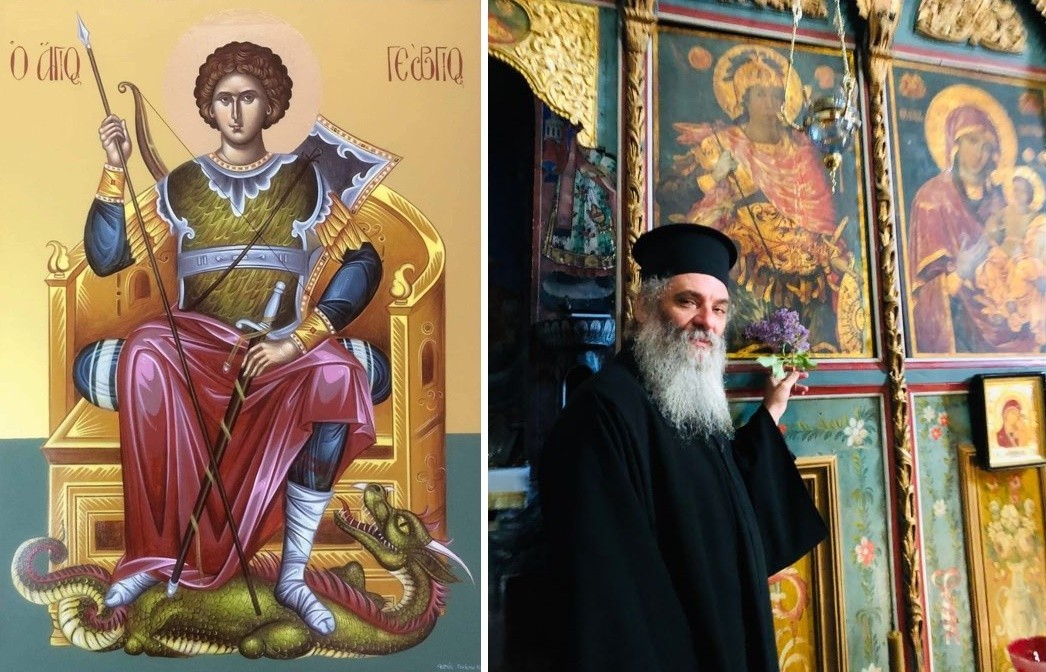
Looking at the blue color on the frescoes, which we just mentioned, and the black color of the monks’ clothes, what do they signify? What is the symbolism of color in the frescoes? I mean in the context of church art and then, in the Bible?
—It is an ancient practice in Orthodoxy, but also in the Christian world in general, for monks and priests to wear black robes, as a reminder of repentance and death, as well as to remind them of the seriousness of their higher calling. If you look at the icons and frescoes of the early Church Fathers, they were all dressed in robes of dark, sober colors. For me personally, and I believe I’m not the only one in this, black also represents joy. Spiritual joy, especially. When I was in the world, whenever I saw a monk, my heart would fill with joy. Their smile, the purity of their face, the cheerful look of the monk or the priest, the warmth of their hearts, all of that is linked to the color black for me, and for me symbolizes the greatest, purest, most sincere childlike joy. It is truly something heavenly because monks are like angels on Earth.
The miracle-working power of the relics of Saint George the Victorious (it is a piece of his hand) is much discussed. It is unquestionable. But everyone (I mean lay people) sometimes wonders how miracles are possible, how it works. Do you have any explanation or interpretation? Is prayer crucial to a miracle happening or is miraculous power inexplicable? Is it because of Christ’s omnipotence?
—In order for a miracle to happen in a person’s life, they need a strong desire to feel God’s will and power, which act when there is great faith and hope, great trust, and love in man for God. When we allow God to move things in our lives and put aside our own will, desires, biases, knowledge, intelligence, and everything that limits us — which we think gives us freedom and breadth of spirit — then God works unhindered because we have allowed Him to act. So, a miracle happens when we surrender the free will that He Himself gave us as an expression of His infinite love for man and return it to Him.
Likewise, during their lives and after their blessed repose, the saints perform many miracles through their relics (the remains of their bodies), in the places where they are now, in the places where they practiced asceticism, where they suffered, or simply in any place when people pray to them from the heart. The saints come to protect and help us with their grace-filled presence. In this way, the wonderful and strong warrior of Christ, St. George the Victorious, has worked through grace for seventeen centuries with his many miracles and healings, and in many cases with visible appearances and help in people’s troubles and pains.
In fact, God is the One who acts through the Saint because Saint George gave himself over to Christ completely and unreservedly. He emptied himself, and with great love for the Savior, he purified himself from the passions of human nature and of the sin rooted within him and re-fashioned himself as a pure vessel in which the Holy Spirit took up residence. The Saint sanctified himself during his life, through righteousness, faith, love, Christian sacrifice, prayerfulness, and spiritual dignity, ending with his martyrdom. Thus, both during his life on earth and after his repose, he continued to perform many miracles and appear to people.
In our monastery, which is dedicated to this Great Martyr of Christ, we possess a part of his relics, more specifically his hand. We keep it in a silver reliquary covered with gilding, made in the shape of a palm, decorated with precious stones, and placed in a silver miniature of a church. We bring the relics out for the faithful who come to venerate the Saint and pray to him. According to their faith, love, and pain, the Saint hastens to answer the prayers and comfort the hearts of the people.
Just yesterday a man suddenly came to the Monastery and told us about a miracle that happened to him. A few years ago the man had a traffic accident near the Monastery and he and the person with him came out of it alive and well. The man came to the Monastery soon after, thanked the Saint, and left. A year later, he came to the Monastery again and after that, he did not set foot in it again. But recently, as a reminder, before he fell asleep, the Saint appeared above his bed and told him: “You forgot me. You have been gone for a long time. You didn’t come to visit me and leave me oil.” The man came to the Monastery the very next day (yesterday) and told us these things.
This is just one of the many miracles that the Saint has performed in our time and that many have testified to us. These include healings from incurable diseases, and apparitions to people in dreams who had never heard about the hand of St. George or had never seen the monastery, and came to us by looking for us based on how it looked in their dreams. Others were delivered from accidents or hopeless situations and the like. However, the Great Saint George the Victorious, who is very much venerated by the people here, does not stop performing miracles daily and testifying to the power of God that works in the Saints, but also in every pure, repentant heart filled with love for Christ who prays to God earnestly with faith and repentance! The power of God always shows itself in our weakness!
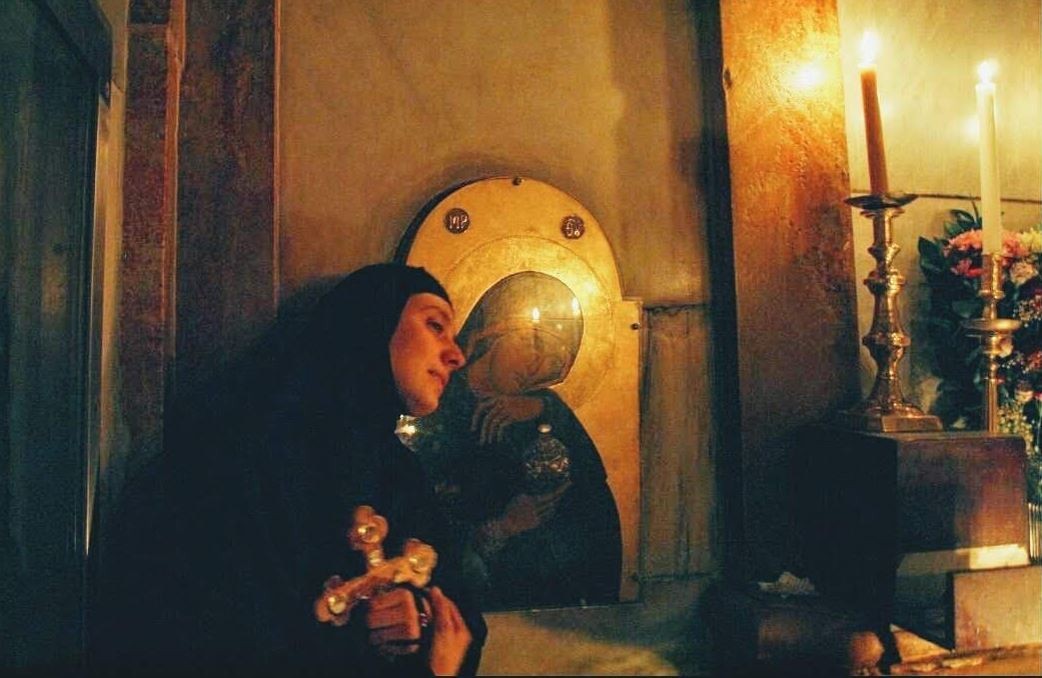
What are the monastic rules that structure the life of the sisterhood and the services? I mean on a normal day, of course. How many nuns are in Rajčica? What obediences do they have? Basically, what is an ordinary day like?
—The Sisterhood of Rajčica Monastery lives according to the typikon that was composed by our Elder Partenij, according to the example of Athonite monasteries. He transmitted that rich and transforming tradition of Mount Athos to us in its entirety, as well as the breadth of hospitality. Our rule naturally involves carrying out the Orthodox Church’s full liturgical cycle, but also hours-long night vigils on Sundays and feast days. We get up early in the morning, around five o’clock, and immediately afterward we are in the church for prayer. Then during the day, we perform numerous obediences. We make souvenirs, we paint icons, and we also make bishop’s miters, for which we are recognized throughout the entire Orthodox world. We also work to ameliorate different societal problems, especially those related to drug and alcohol abuse.
Recently, we have also had a lot of construction activities at our monastery, which includes the reconstruction and extension of the existing buildings, but also the construction of new ones. We are in the process of building a magnificent new church dedicated to St. George, new living quarters, as well as the construction of a day center for children’s education and recreation, especially children without parental care.
The monastic day ends in the evening with prayer in the cells. The beautiful hymns and soothing verses written by the Holy Fathers and hymnographers remind us of one of the most important monastic rules, to which our Elder constantly refers: “Everything is made of love. He who loves fulfills all of God’s commandments.”
One craft that isn’t often encountered, and yet is the main occupation of the sisters in the Monastery, is the making of miters for bishops and patriarchs, including the Ecumenical Patriarch. I am interested to know why are they special. And stylistically, what influences dominate? What materials do you use, in terms of fabrics, stones, etc.? Do you use real jewels? What is the meaning of a crown in the Bible?
—Our most beloved Elder, Bishop Partenij gave us a truly precious blessing: the making of bishop’s miters, which he bequeathed to us as an obedience, thus passing on his love for this noble and creative craft. Of course, creating a miter is a grace-filled act, but we must also say that it is not easy at all. This obedience requires us to spend hours and hours bent over the miters we make, trying to remember with each prick of the needle the crown of thorns of our Lord because the miter essentially symbolizes just that. The other symbolism is of course the royal majesty of Christ because a bishop represents Christ the King and His Royal Priesthood during the divine services. Miters are part of a bishop’s liturgical vestments and therefore should be a reflection of heavenly glory, and such dignity also requires a worthy decoration. We use only high-quality materials, precious metals, semi-precious stones, and pearls, which can give an elegant shine to a liturgical piece, and which witnesses to the brilliance of Christ resurrected in glory.
I would also like to add here that for me and all the sisters, embroidering miters encourages us to think about the Mother of God as well because She also made clothing for her Son, and at the same time used the long hours of embroidering to prayerfully raise her mind to God and thus dwelt in unceasing devotion. Moreover, God rewards this handiwork with special grace. In particular, with my sanguine temperament, I never thought that one day I would be able to do this and not only do it but also enjoy it so much and that the hours spent in making such a sacred object would end so quickly.
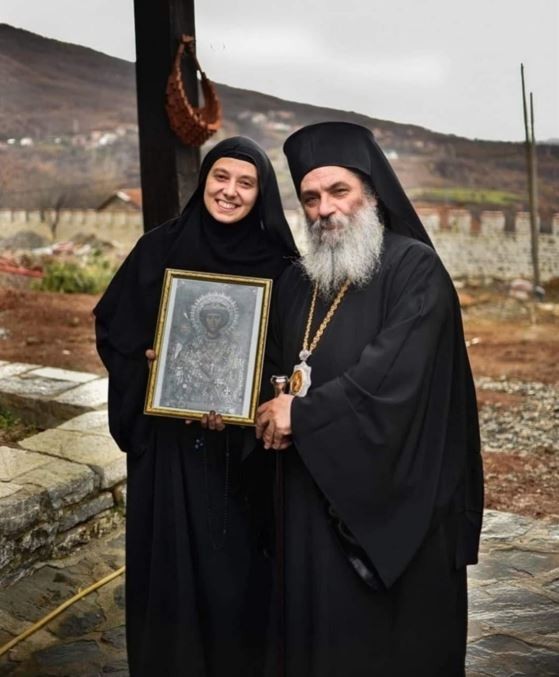
As a result of the burdens we face in our daily lives, fear (for our children, the future, even human existence is at stake) and anxiety are increasingly prevalent among ordinary people. How can we overcome them, how can we reach humility and peace of mind? I mean individually because the sense of collectivism has long been lost already.
—Modern people are so empty because they live their lives at such a fast pace and with so much superficiality. For example, today man prays for rain, but forgets that mud is also a consequence of rain. We have a choice to either stay scared in the mud or try to master it and learn how to use it to strengthen our muscles. Without Christ in our lives, we remain in the mud because no matter how much we have succeeded in life, even the greatest worldly dignity that people may give us remains tied to the earth. It stays here! We were created for something higher, something that cannot be substituted for by any worldly dignity, nor can it be bought with the wealth of this world. Don’t forget, the most precious and lasting things are what money can’t buy: faith, hope, love, joy, and goodness. All fears come from a lack of faith. That’s why I don’t stop praying: Dear Lord, I’m not asking you to remove all the stones from my path, but to strengthen my shoulders, so that I can carry those stones from the path of my life.
We have forgotten that faith works every miracle. Our Elder constantly teaches us to keep our faith intact and that faith is the head of man. Without faith we have nothing! Without faith, I can only have a good desire, which, injured by the waves of life, will soon drown. Our strength to fight for any good desire or goal will fail because true strength is only in faith in God! Fear comes from a lack of faith. We especially fear that we have not recognized or started to live what our purpose is. Every good desire and goal requires sacrifice.

When it comes to Christianity, its ethics, and women, what are the essential qualities of a real Christian woman? What would most characterize her?
—For me, motherhood has always been the greatest and most sacred thing. The mother is the strongest driving force, not only of a family but also society. She must not forget the most important thing, which is that as a woman and as a mother she should bring peace wherever she goes. Here it must be mentioned that a man also has his own role, a wonderful family, and a social role that fits his nature. He is a father, and he tries to protect and establish his family, but even amid the many obligations that are put in front of him, he must not forget that his most important role is treating his wife with love. When a woman is truly loved, she can do a lot, both for her family and society. Having said that, I will paraphrase our Elder’s words, who says very often that not only are women not weaker than men but that in Christ a woman is even stronger than a man. Our Lord gave the greatest rights to women, he turned humiliated and despised people into the strongest and most faithful preachers for equality, brotherly love, and mercy. These are all maternal qualities, so we say that a woman’s highest role is to be a mother. A child needs only one thing: to feel their parents’ love. Therefore, let us hurry to surrender to the Heavenly Father and let His hand lead us where He wishes because His love is eternal. In this way, all fear will disappear, as He Himself told us: “I am with you always even unto the end of the age. Amen” (Matthew 28.20).
When it comes to visiting monasteries, is it mandatory for women to wear a headscarf and a skirt or dress? What is proper? Is this based on the words of Saint Paul the Apostle? What does all this really mean?
—When it comes to how Christians should dress, people often go to extremes. In general, I get the feeling that many people are more concerned with form than substance. Not that the form is not important, on the contrary, it contains the essence, but the latter should always have priority. This also applies to how believers should dress. Of course, for believers, there is no uniform appearance, a strict template according to which everyone should look. One thing is important here: when people visit a church, but also in general, they should not look indecent or provocative, so as not to cause scandal to others or become culpable in someone’s downfall. What is even more significant is that the believers do not lead a double life, one inside the church in front of other believers, and another when they are apart from other Christians which is completely different from the first. God does not like hypocrisy. Regarding the headscarf, I think that it is more of a cultural custom than any established rule. For example, in Russia, almost all women in church wear a headscarf, while in Greece, none do. However, this in no way means that Russian women are more pious and better than Greek women. In any case, it can be said that the headscarf falls under the code of decent dress. In my humble opinion, everyone should act according to their own conscience and conviction, without imposing the same on others or, God forbid, condemning them because they do not emulate him/her. If we do something only to externally look better than others, then, believe me, we will be worse than those who do not follow any such rules and yet have sincere repentance and humility in their hearts. The Holy Apostle Paul, who advises men to love their wives as Christ loved the Church and gave himself up as a sacrifice for her, also advises women to “adorn themselves with modest apparel, with propriety and moderation…with good works” (1 Timothy 2:9-10). He writes again: “Do you have faith? Have it to yourself before God. Happy is he who does not condemn himself in what he approves” (Romans 14:22).
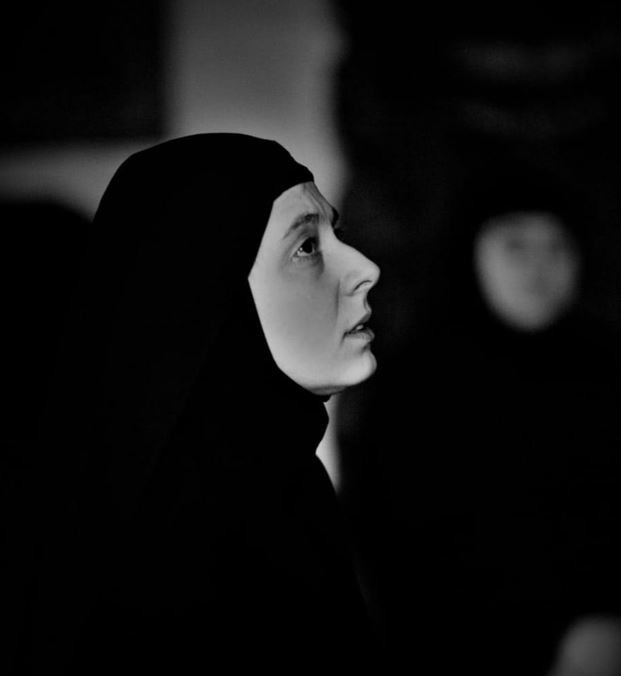
Igor Landsberg
Photos: Archives of the Monastery of St. George the Victorious










